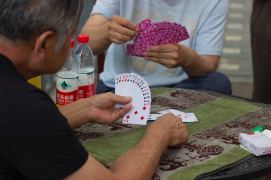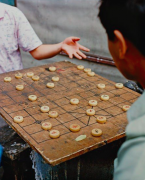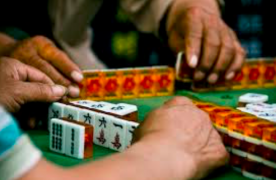Three Beijing Board Games You Should Know
If you have ever strolled through the Hutongs of Beijing, you might have noticed throngs of locals gathered around small outdoor tables. Don’t worry if you haven’t witnessed it yet – the eruptions of laughter and emphatic slaps to the tabletop are hard to miss. If you peer over the fence of shoulders, you’ll likely find a game at the center of the group. It is even more likely it will be one of three: Xiang Qi, Dou Di Zhu, or Mahjong. Each of these games represent a snapshot of Chinese history with meaning you can only appreciate with an understanding for the era’s culture that brought it about.
Whether you have a deep appreciation for Chinese culture or just simply enjoy board games, below you will find a brief introduction that will better prepare you to enjoy either on your next outing in the Beijing hutongs.
Dou Di Zhu – Beat the Landlord

Dou Di Zhu is a gambling card game played by three people. On thesurface, it’s a game of chance: two people agree to split the winnings if one of them wins, where the third person faces double the pay if they win, or double cost if they lose. Though, once translated, the name reveals something deeper: Dou Di Zhu roughly translates to Beat the Landlord.
Dou Di Zhu originates from the class struggle during the cultural revolution when the poor were encouraged to retaliate against the wealthy. Despite violent and tumultuous origins, the game that is played today largely lacks negative connotations – hence it’s popularity. If you’d like more information on the game, a succinct introduction is offered by the Youtube channel “Street Food”.
Xiang Qi – Chinese Chess

Xiang Qi is no different. Often referred to as “Chinese Chess” because of its similarity to international chess, Xiang Qi is a game of strategy between two players. Xiang Qi has pawn, bishop, king, horse and rook equivalents, but also has major logistical differences from international chess. For example, Instead of placing the pieces within the squares, they are placed on the intersections of the lines. Furthermore, parts of the board like the “River” and the “Palace” restrict or enhance movements of certain pieces.
Though Xiang Qi does have a fantastic creation-story involving expanding mouse doors, hidden tombs and messages from the dream world – it also has a more tangible history. Proof of its existence has been found in letters left behind by Generals and Scholars throughout China’s history. And historians have used the clues to trace the origin of this game back to war tactics employed in the warring states period – meaning Xiang Qi has it’s origins in war.
Perhaps Xiang Qi’s turbulent origins explain it’s clamorous style today: Xiang Qi tends to attract the largest of groups and inspire melodramatic synergy between it’s players. Unlike the delicate handling of chess pieces, players of Xiang Qi opt to slap the circular wooden pieces to the board for emphasis. Likewise, these players contemplate their moves as fingers from the crowd dodge in and out from above the board to draw lines of suggestion and offer unsolicited advice. If you would like to learn more about Xiang Qi, take a look at SinoVision’s post on Youtube.
Mahjong

Last, but certainly not least, is Mahjong. Although it is less common for people to crowd around to watch mahjong, it remains a critical piece to the Beijing board game culture.
The mahjong games scattered among the Beijing communities are four player games which consist of 144 tiles. The goal of the game is to get a Mahjong: a sequence of 13 tiles comprised of two melds (Meld: a specific sequence of tiles) and a pair. After players pick up their initial 13 tiles, people take turns in a counter-clockwise motion picking up and discarding tiles until someone reaches a Mahjong. More information on how to play Mahjong can be found on Youtube, posted by Asia Pacific Mahjong.
Like Xiang Qi, it’s origin story waivers between tangible and intangible history. There are theories it was Confucius who introduced the game, and other theories that it was born during the Taiping Rebellion by Chinese officers – but it nevertheless provides a context for Chinese culture to exist through time much like the other games.
These games are in one way a snapshot of Chinese history, frozen in time, and in another, a vessel for Chinese culture to traverse time. They are dynamic pieces of culture which present themselves briefly before you – and in this age of fast moving technology, who knows how long they will stick around for. If you get the chance to witness one of these games, don’t be timid; respectfully inquire and partake in the moment, because to miss a chance to partake in these moments, is to miss a chance to appreciate these moments.